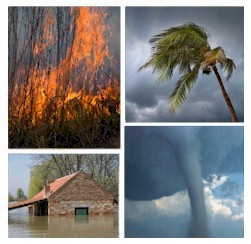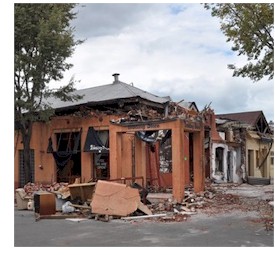|
|


Disaster Alert Systems and Services
 This section of our technical library presents articles written about Emergency Alert Systems and Disaster Recovery definitions, terms and related information.
This section of our technical library presents articles written about Emergency Alert Systems and Disaster Recovery definitions, terms and related information.
The 911Broadcast emergency notification and alert service can deliver a large number of phone calls using a network of phone systems employing digital phone lines simultaneously. Should a disaster such as a snow storm, wild fire or flood hit your area, 911Broadcast systems can alert your community quickly providing specific instructions if an evacuation is required.
This service is available using our emergency broadcasting systems. If a dangerous chemical spill occurs in your community, you can target specific areas to call. If a severe snow storm hits your area, your community can be notified of school closings or event cancellations.
Contact DSC Today for a FREE analysis and quote and to learn more about our emergency notification systems and services.
Monitoring Earthquakes
The following information is an extract from an article "Why Monitor Earthquakes?" published at
Seismology Research Centre, www.seis.com.au
The article poses several questions about earthquake monitoring and some of the key technologies and issues associated with it:
Purposes of Earthquake Instrumentation
Hazard - study of earthquakes and their effects, where they occur, how big and how often (the task of a seismologist).
Vulnerability of structures - prevent collapse and minimise structural damage
(the task of an earthquake engineer).
Risk - alerts, warnings and alarms for preparation and emergency response
(the tasks of management and operating staff).
Earthquake Hazard
Earthquake Source Parameters
- origin time and rupture duration.
- earthquake location - epicentre and depth.
- earthquake size - magnitude, rupture area.
- rupture process - focal mechanism.
Seismic Wave Travel Path
- velocity models, needed to locate earthquakes.
- attenuation functions, to quantify hazard.
Site Effects
- site amplification of ground motion by sediments or topography.
Regional Earthquake Catalogue
- activity rate, the proportion of small to large events, maximum credible magnitudes for particular structures or areas.
- delineation of active faults.
- an earthquake recurrence model.
Earthquake Vulnerability
The response of a structure is found by comparing motion on the structure and at its foundation with nearby bedrock motion.
- Structure response is highly frequency-dependent.
- Horizontal motion is more important than vertical.
- Translational ground motion can induce torsion in an asymmetric structure.
Response to small or distant events will help predict the elastic response to large nearby earthquakes (but not inelastic response).
Comparison of the dynamic properties (natural periods) of a structure before and after an earthquake may give an indication of hidden damage.
Earthquake Risk Management
When seismic monitoring is used for emergency response purposes, all parties involved should understand what is possible and what is not. Although earthquake prediction is highly unreliable, other useful information can be provided, both before and after an earthquake.
Misunderstandings can be avoided by careful definition of terms. The following terms apply to hazards in general, including fire, flood, cyclones, and earthquakes.
Hazard Recurrence Estimates give long-term probabilities that effects will be experienced at a site or throughout an area. They do not consider any particular event, but only the long-term average recurrence. These are useful in prioritising upgrades or renovations to structures, and the resources allocated to emergency response when a range of hazards must be considered.
Alerts may be issued when there is an enhanced but unspecified probability that a particular phenomenon may occur. For example, in hot windy weather a bushfire alert may be declared.
Forecasts give the location, time and size of a future event, together with an estimate of the probability that the event will or will not occur.
Predictions give the location, time and size of a future event that will happen. Prediction of most events, natural or caused by people, is usually highly unreliable.
Warnings are issued after an event has occurred and before its effects have been experienced. For example, a tsunami warning may be issued after an earthquake has occurred and before the tsunami has arrived. Warnings should give estimates of the impact or intensity of the effects and of the time that they will occur.
Alarms are issued after an event has occurred and after its primary effects have been experienced. Their purpose is to provide useful information about the event that will assist in the response to that event.
Earthquake Emergency Response
Earthquakes are one of the most significant geohazards, especially for casualties and damage. Floods affect more people, but normally do not produce widespread fatalities.
Earthquake hazard recurrence varies greatly from highly stable areas within some continents, to very active areas at the boundaries of tectonic plates. The character and effects of earthquakes differ significantly from place to place depending on several factors, including the earthquake depths, the type of forces that produce them, and the properties of rock and surface sediments. Preparation and response is also affected by the recurrence rates of earthquakes. Economic factors may be very significant, and the money spent on building standards or response preparation may differ significantly between a site where a magnitude 7 earthquake may be expected every 200 years, and a site where it may be expected every 200,000 years.
Australia is in a stable continental region, although it is probably the most active of such regions (possibly because of the very active plate boundaries to the north and east). Damaging earthquakes are infrequent, but when they do occur they can have considerable impact, depending on building standards and response preparation.
Earthquake alerts may be given when unusual earthquake activity (that may be precursory) has been detected, and there is a possibility that a larger event may occur. For example, in Australia, the probability of a magnitude 5 earthquake in the vicinity in the next few days may be 1 in 10,000. If a magnitude 3 earthquake occurs, it may be a foreshock for a larger event or it may itself be the largest event in an earthquake cluster sequence. Given the proportion of magnitude 3 events that are foreshocks, the probability of a magnitude 5 in the next few days may increase to perhaps 1 in 100.
Earthquake forecasts and especially earthquake predictions are notoriously unreliable. It is normal to hear of successful predictions only after the event.
Earthquake warnings can only be given in special circumstances because seismic waves travel quite fast. A seismograph network close to the earthquake may give enough seconds warning to the surrounding region to allow action to be taken. For example, a generator may be disconnected from a turbine to reduce damage. In Japan, offshore earthquakes may be detected in time to slow high-speed trains. In Mexico City a warning system that detects large earthquakes to the south gives up to a minute for people to prepare for the arrival of seismic waves. Tsunami warning systems are useful because seismic sea waves from distant earthquakes usually travel at only a few hundred kilometres per hour, often giving many hours warning.
Earthquake alarms are designed to provide useful information about an earthquake that has already occurred and its primary effects may have already been experienced. However, because of communication failure or overload, relevant decision makers and emergency services cannot be aware of all that has occurred. However, if the location and size of the earthquake can be determined quickly, estimates of its effects can be made to assist in the initial response to the event. When actual damage information is obtained, this will control the emergency response.
Copyright © 1998, Seismology Research Centre
Earthquakes - Emergency Dialers For Earthquake Alerts
 Should an earthquake strike in your area, our phone service could help notify your community quickly with emergency instructions. With our emergency notification phone service, emergency warning messages can be broadcast to thousands of households in your community.
Messages can be simultaneously delivered in just minutes using our network of phone systems and services.
Should an earthquake strike in your area, our phone service could help notify your community quickly with emergency instructions. With our emergency notification phone service, emergency warning messages can be broadcast to thousands of households in your community.
Messages can be simultaneously delivered in just minutes using our network of phone systems and services.
Pre-recorded warning messages can be played giving households information regarding the earthquake location and whether a community evacuation is planned or necessary.
You can send a broadcast warning to specific neighborhoods or communities in the event of an earthquake and provide priority delivery of these messages to those nearest the earthquake epicenter. Multiple messages can be delivered to different members of the community based upon proximity to the disaster.
Calls can be directed to operators that are standing by to handle special individual emergencies.
Messages can also be broadcast seeking volunteers or special assistance from emergency personnel.
Other applications include warning residents in a geographic area when the danger associated with the results or aftershock of an earthquake is at a high level. Travel and activity restrictions can likewise be broadcast using this service.
Earthquake alert messages sent to households in this fashion can be simple warnings with specific or general instructions. If the community needs feedback from the call, an interactive response can be programmed into the message allowing the person to either acknowledge the call or to contact someone. Messages can vary based upon proximity to the event, with different degrees of broadcast warning and instructions.
|




 This section of our technical library presents articles written about Emergency Alert Systems and Disaster Recovery definitions, terms and related information.
This section of our technical library presents articles written about Emergency Alert Systems and Disaster Recovery definitions, terms and related information.
 Should an earthquake strike in your area, our phone service could help notify your community quickly with emergency instructions. With our emergency notification phone service, emergency warning messages can be broadcast to thousands of households in your community.
Messages can be simultaneously delivered in just minutes using our network of phone systems and services.
Should an earthquake strike in your area, our phone service could help notify your community quickly with emergency instructions. With our emergency notification phone service, emergency warning messages can be broadcast to thousands of households in your community.
Messages can be simultaneously delivered in just minutes using our network of phone systems and services.